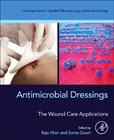
Antimicrobial Dressings: The Wound Care Applications demonstrates the literature about the catalytic behavior of proteolytic enzymes immobilized together with nanoparticles. Numerous applications using proteolytic enzymes for debridement, silver as antibiotic and nanoparticles for enzyme immobilization were developed in the last years. However, the interdisciplinary information combining nanotechnology, biotechnology and medicine is still in its early stages. Antimicrobial Dressings: The Wound Care Applications adopts a holistic approach in a life cycle context to evaluate their final feasibility including industrial exploitability without disregard the potential risks of enzymes and nanomaterials to human health and the environment. describes the drawback of using unstable enzymes in wound debridement such as infections, irritations, low availability, rapid elimination from the body, and impossibility of creating a high local concentration of the preparation without increasing its systemic concentration Provides information on higher efficient antimicrobial property and enzyme stability using nanoparticles as carriers for enzyme immobilization due to minimum diffusional limitation, maximum surface area per unit mass, and high enzyme loading Discusses the physical characteristics of the nanoparticles through multilayer polyelectrolytes encasing, such as diffusion and particle mobility that will influence the catalytic activity, pH and thermal stability of attached enzymes Describes the use of nanoparticles in wound debridement controlling the structure and properties of the assembled polyelectrolyte films at the molecular level and using nanoparticle with size higher than 30nm INDICE: Overview and Summary of Antimicrobial Activity in Wound Dressings and its Biomedical Applications2. Traditional and Modern Wound Dressings- Characteristics of ideal Wound Dressings3. Nanoparticles as Potential Antimicrobial Agents for Enzyme Immobilisation in Antimicrobial Wound Dressing4. Polyelectrolyte (PEM) assembly with NP-Immobilized Enzymes5. Role of Debridement and its Biocompatibility in Antimicrobials Wound Dressing6. Different Immobilized-Enzyme Nanoparticles Multilayered Preparations7. Kinetic, Stability and Activity of the NP-Immobilized Enzymes8. The Antibacterial Hydrogel Dressings and their Applications in the Treatment of Wound9. Medicated Wound Dressings10. Clinical Effectiveness of Antimicrobial Dressing11. Blocking and immobilization of electrospun fiber for biomedical applications12. Future research directions of antimicrobial wound dressing
- ISBN: 978-0-323-95074-9
- Editorial: Academic Press
- Encuadernacion: Rústica
- Páginas: 275
- Fecha Publicación: 01/04/2023
- Nº Volúmenes: 1
- Idioma: Inglés
